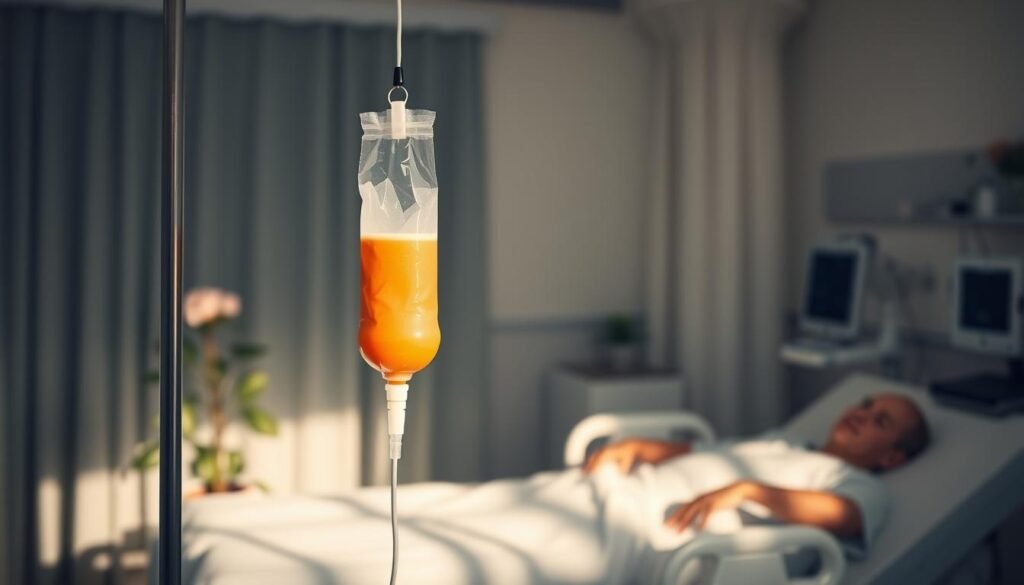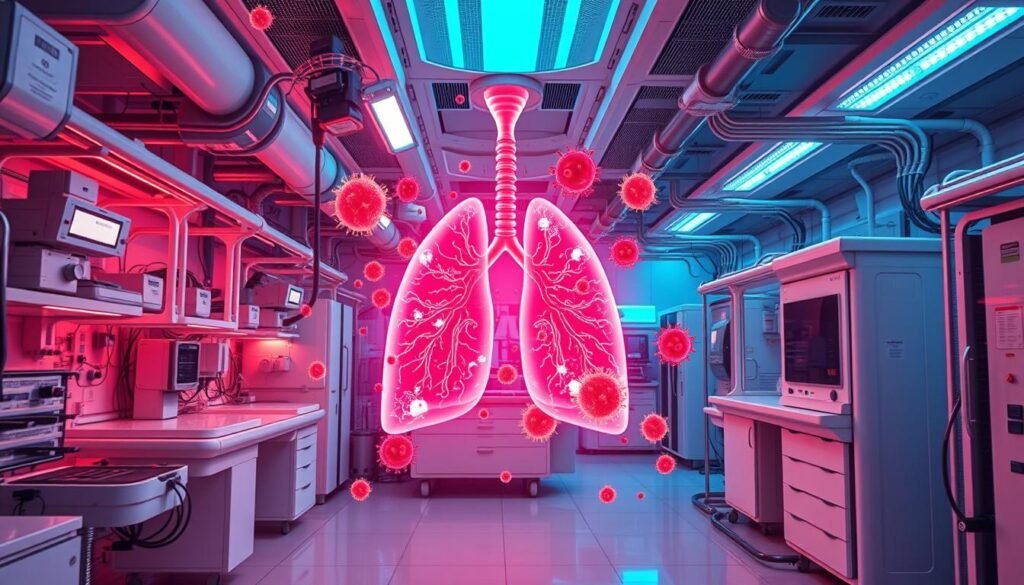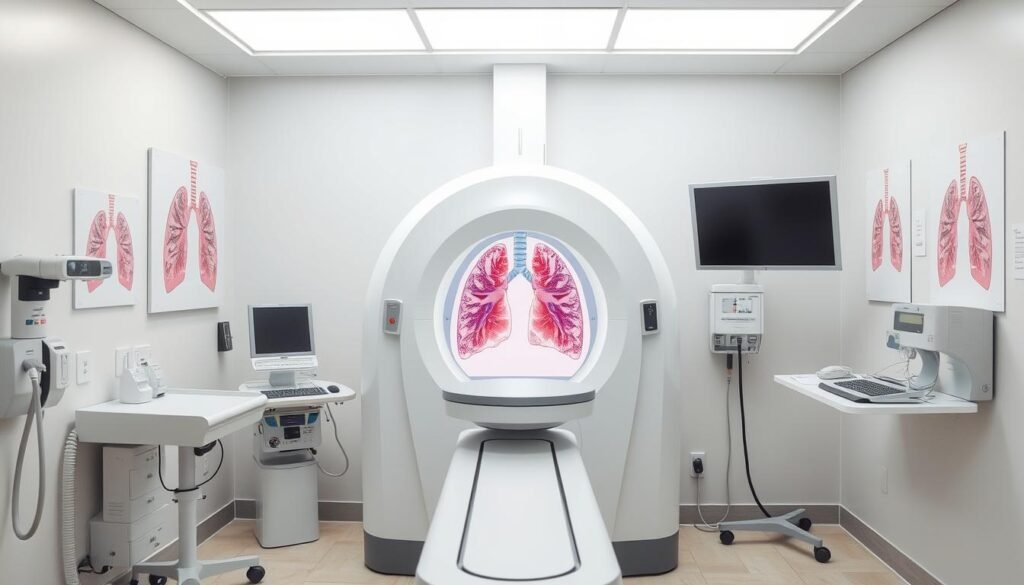Did you know that nearly 85% of all lung cancer cases are non-small cell lung cancer? This type is by far more common than its small cell counterpart. Early detection of lung cancer opens a window of opportunity for patients. Treatment options at this stage can lead to much better outcomes.
It is key to understand the different lung cancer treatments available. The choice of treatment depends on factors like tumor size, its location, and the patient’s overall health. A multidisciplinary approach helps create tailored treatment plans for each patient. This article will explore surgical methods, chemotherapy, and more for treating early stage lung cancer.
Key Takeaways
- Non-small cell lung cancer (NSCLC) is more prevalent than small cell lung cancer.
- Early detection of lung cancer can significantly enhance treatment outcomes.
- Surgery remains a common treatment option for early stage lung cancer.
- Combination therapies, including chemotherapy and radiation, may follow surgical intervention.
- Clinical trials are an essential avenue for exploring new treatment options.
- Minimally invasive procedures can offer reduced complications for eligible patients.
- Consulting with healthcare professionals about complementary medicine options is advised.
Understanding Early Stage Lung Cancer
In the early stage, non-small cell lung cancer (NSCLC) is still within the lungs. The cancer cells haven’t spread yet. This improves chances for successful treatment. NSCLC makes up about 85% of all lung cancers, making it crucial to understand.
Knowing the stage of lung cancer is key for treatment. Early stage lung cancer usually means Stage I, where the outlook is good. For people with stage 1a NSCLC, the five-year survival rate can be as high as 77%. But, survival rates drop in later stages. Spotting early symptoms like ongoing cough, chest pain, or losing weight without trying is vital. Acting on these signs quickly can help beat cancer, as shown by this helpful resource.
The type of lung cancer is important in planning treatment. NSCLC has different subtypes, each unique. Knowing the subtype helps doctors find the best treatment. Surgery might remove the tumor in some patients. Other treatments may include radiation and radiofrequency ablation.
New treatments are being found all the time. It’s important to keep up with this research. Treatments usually include several methods, sometimes even chemotherapy after surgery. It’s also vital to understand the stages of lung cancer for the best care.
Talking with lung cancer specialists helps in getting tailored care. Support groups can provide emotional help and updates on lung cancer research.
Importance of Early Detection
Finding lung cancer early is key to better treatment and living longer. Lung cancer is the second most common cancer and the top reason for cancer deaths in the U.S. It’s a big health problem. Using lung cancer screening with low-dose CT scans helps find it early when it’s easier to treat.
Studies show that CT scans can lower death rates from lung cancer by 20% compared to regular chest X-rays. The American Cancer Society suggests yearly CT scans for people 50 to 80 who smoked a lot. This is for those who have smoked for 20 years or more. Catching cancer early means treatments work better.
Even though CT scans have a bit of radiation, the chance to catch cancer early is worth the risk. Centers that do these scans must have the right gear and know-how. They also should help smokers quit. This tackles a main cause of lung cancer.
When caught in stage IA, over 90% of people live at least five years. But if found in stage IV, less than 10% survive that long. This shows how crucial early detection is.
Screenings are vital for people at high risk. New tools like liquid biopsy could make early detection even better. Liquid biopsy is a new tech that finds cancer signs early in the blood.
To sum up, screening often, like with CT scans, is a game changer for fighting lung cancer. It means better chances for those affected and helps fight against lung cancer deaths.
To know more, learning about the similar signs of COPD and lung cancer can help. It tells you when to get checked. More info is available here.
Treatment Options for Early Stage Lung Cancer
Early stage lung cancer comes in stage 1A or 1B, based on the tumor’s size. Stage 1A tumors are no bigger than 3 centimeters. Stage 1B tumors are over 3 centimeters but less than 4 centimeters. Many people don’t have symptoms at first, but screening tests can find these cancers early.
Overview of Treatment Strategies
The main treatment for early stage lung cancer is usually surgery. Here are some surgical options:
- Lobectomy: Taking out a whole lung lobe.
- Segmental Resection: Taking out a lung segment.
- Sleeve Resection: Removing part of the airway.
Some patients may get radiation therapy instead of surgery. This can target the tumor closely, saving healthy tissue. After surgery, chemotherapy might be recommended, especially if there’s a high chance of cancer coming back. Chemotherapy stops cancer cells from growing or dividing.
Personalized Treatment Plans
A good personalized lung cancer treatment plan is made just for the patient. Doctors look at the patient’s genes, health, and what they want. Then they make a plan that works best. They might use targeted therapies after surgery. These focus on the cancer’s specific genes and proteins. This makes treatment more effective and reduces bad side effects.
For early stage lung cancer, the outlook is quite good. The five-year survival rate for stage 1 non-small cell lung cancer is 64 percent. For more on treatment options, check out Mayo Clinic’s lung cancer treatment guidelines.
Lung Cancer Surgery
Lung cancer surgery is key in treating early-stage non-small cell lung cancer (NSCLC). It can greatly improve patient outcomes. Various surgeries are available, based on the tumor and patient health. Knowing these options helps in choosing the right treatment.
Types of Surgical Procedures
Different methods exist for lung cancer surgery:
- Lobectomy: Removes a lung lobe, mainly for NSCLC.
- Pneumonectomy: Takes out one lung, used for advanced disease.
- Segmentectomy: Takes out a lung segment, saving more lung tissue.
- Wedge resection: Cuts out a wedge-shaped lung piece, for smaller tumors.
- Sleeve resection: Removes part of the bronchus with the tumor, keeping lung function.
There are traditional open surgeries (thoracotomy) and less invasive ones like VATS and RATS. Studies show that patients who have lung-sparing surgeries face fewer serious problems than those who have lobectomies.
Post-Surgery Care
Care after surgery is vital for recovery. It involves:
- Watching for issues like bleeding or infection.
- Managing pain with medicine.
- Doing physical therapy or pulmonary rehab to better lung function and strength.
- Removing drainage tubes usually a few days post-surgery.
Recovery time varies by surgery type and patient health. After surgery, many feel tired and have some pain. Personalized care after surgery helps meet individual needs, aiding in regaining strength and mobility.
Radiation Therapy for Lung Cancer
Radiation therapy is a key treatment for lung cancer patients who can’t have surgery. It uses high-energy X-rays to kill or stop the growth of cancer cells. It’s especially good for treating stage 1 non-small cell lung cancer. Those who can’t undergo surgery, or prefer not to, may find it helpful.
Stereotactic body radiotherapy (SBRT) is a modern method used mainly when cancer is just in the lung. It delivers high radiation doses in 1 to 5 sessions. This accuracy means less harm to healthy tissues while attacking cancer.
External beam radiation therapy (EBRT) is the most common form of radiation treatment. It usually happens five days a week for five to seven weeks. Treatment sessions are quick and painless but may cause skin issues and coughing.
Most side effects improve two months after treatment ends. However, some late effects can appear later. Eating well is vital, as healing uses lots of energy. After treatment, regular check-ups are key. These start frequent then become yearly.
Radiation often combines with other treatments like chemotherapy or surgery. This mix attacks lung cancer from different angles. It offers a personalized approach, suiting each patient’s needs.
| Radiation Therapy Technique | Description | Potential Side Effects |
|---|---|---|
| External Beam Radiation Therapy (EBRT) | Most common method, delivering radiation from outside the body. | Fatigue, skin changes, sore throat, cough. |
| Stereotactic Body Radiotherapy (SBRT) | High-dose radiation in fewer sessions, for localized tumors. | Nausea, mild skin reactions, tiredness. |
| Brachytherapy | Internal radiation therapy used to alleviate symptoms. | Swelling, local irritation, discomfort. |
| Proton Therapy | Uses proton beams to minimize damage to surrounding organs. | Fatigue, potential lung damage, memory issues. |
Chemotherapy: Role in Treatment
Chemotherapy is key in treating early stage lung cancer, often alongside surgery. It includes neoadjuvant and adjuvant chemotherapy. Neoadjuvant chemotherapy works to reduce tumors before surgery, sometimes with radiation therapy. Adjuvant chemotherapy after surgery aims to kill remaining cancer cells, reducing recurrence chances.
Common Chemotherapy Combinations
The choice of chemotherapy drugs depends on the lung cancer type, tumor features, and patient health. Typical combinations for non-small cell lung cancer (NSCLC) include:
- Cisplatin with vinorelbine
- Carboplatin with paclitaxel
- Carboplatin with pemetrexed
- Cisplatin with docetaxel
Treatments are given in cycles, lasting three to four weeks. This schedule allows patients to recover between treatments. Chemotherapy is mainly given through a central line, but some drugs can be taken orally.
Chemotherapy has risks and side effects like hair loss, fatigue, and nausea. Healthcare professionals must manage these carefully. It’s a crucial part of the treatment plan, working with surgery and radiation for the best outcomes.

Targeted Therapy: A New Frontier
Targeted therapy is a big step forward in lung cancer treatment. It matches treatments to specific genetic changes in cancer cells. This approach, known as precision medicine, picks drugs that directly target cancer’s unique traits. This leads to better results for patients. Medical tests find these genetic changes. Then, doctors can choose the best therapy for each person, making treatment more effective.
How Targeted Therapy Works
Targeted therapy attacks genes or proteins that help cancer grow and survive. For example, in non-small cell lung cancer (NSCLC), changes in the EGFR gene or ALK fusion genes are common. Drugs have been made to target these changes. They stop the signals that make cancer cells multiply.
- EGFR Inhibitors: Drugs like gefitinib and erlotinib block growth signals in cancer cells. They work well, with a 72% success rate in patients with EGFR mutations.
- ALK Inhibitors: Crizotinib focuses on ALK changes and has a 65% success rate. Newer ALK drugs, like ceritinib and alectinib, may lead to longer survival than crizotinib.
- Third-Generation TKIs: Osimertinib is a newer option that’s good at fighting certain resistance mutations, like T790M. It has led to better treatment results.
Genetic tests for cancer are key to finding these mutations and choosing the best therapy. With precise information on a tumor’s genetics, targeted therapy can be tailored to each patient. This means treatments work better, are easier to tolerate, and lead to longer survival.
| Targeted Therapy Type | Example Drugs | Response Rate | Unique Features |
|---|---|---|---|
| EGFR Inhibitors | Gefitinib, Erlotinib, Osimertinib | 72% | Effective for EGFR mutations, specifically T790M |
| ALK Inhibitors | Crizotinib, Alectinib, Ceritinib, Lorlatinib | 65% (1st), Higher for 2nd-gen | Targets ALK fusion genes, with newer drugs overcoming resistance |
Immunotherapy’s Potential
Cancer treatment has changed a lot recently, especially with immunotherapy for lung cancer. This method uses the body’s immune system to fight cancer cells. Drugs like atezolizumab, pembrolizumab, and nivolumab are key in treating non-small cell lung cancer (NSCLC).
The FDA has approved these drugs because they help improve survival rates. They work well in many patients with advanced lung cancer. Traditional treatments like surgery and chemotherapy have limits. But immunotherapy is offering hope for longer remissions, especially through targeting the PD-1/PD-L1 pathway.

Fascinating research shows different five-year survival rates among those getting immunotherapy. In early-stage cases, the results are very varied. This shows the need for more research. Immunotherapy hasn’t just helped people live longer; it’s also stabilized them for extended times. Beyond that, new methods like cancer vaccines and T cell therapies are being explored.
Lung cancer is a major issue, causing more deaths than breast, prostate, and colon cancers combined. But immunotherapy offers new hope. Research is ongoing, bringing new discoveries into the battle against this widespread illness.
| Immunotherapy Approach | FDA Approval Year | Commonly Used Drug |
|---|---|---|
| Immune Checkpoint Inhibitors | 2015 | Pembrolizumab |
| Anti-PD-1 Therapy | 2015 | Nivolumab |
| Combination with Chemotherapy | 2021 | Nivolumab + Platinum-doublet |
| Adjuvant Setting | 2020 | Atezolizumab |
Watchful Waiting: When is it Appropriate?
Watchful waiting is a key method for handling early lung cancer. It means closely watching a tumor’s growth without starting treatment right away. This is especially for certain patients. Some lung cancers grow slowly, letting patients live well for a long time without trouble from the tumor.
Active surveillance is part of watchful waiting. It helps patients see how their cancer is doing. They might stop treatments like chemotherapy to watch how the tumor acts. Then they can decide on trying new treatments such as immunotherapy. This careful choice can bring lasting benefits.
Choosing watchful waiting might cause worry. Talking often with doctors helps ease this anxiety. Knowing more about this plan reduces stress and helps understanding. Finding emotional support from counseling or groups can also help during this time.
Some patients fear their cancer isn’t being taken seriously with watchful waiting. But, doctors choose it for good reasons, based on each person’s situation. Studies show that patients watched closely don’t face higher risks than those treated right away.
Treating early lung cancer is very personal. Regular check-ups and talking openly with the health team are crucial. This ensures that any changes are noted promptly. It helps everyone stay informed and confident about the treatment path.
Lung Cancer Screening: Prevention and Early Detection
Lung cancer screenings are key for early detection of lung cancer. They greatly improve the chances of survival. Sadly, only 21% of lung cancers are found early, at stage I. Without prevention strategies, too many are missed until it’s late, making effective treatment hard.
The US Preventive Services Task Force (USPSTF) advises yearly scans for those 50 to 80 with a history of heavy smoking. This is crucial for current smokers or those who have quit in the last 15 years. The National Comprehensive Cancer Network® (NCCN®) agrees, aiming to catch cancer early in those at higher risk.
Low-dose CT scans are quick, non-invasive, and generally painless. However, concerns exist about insurance coverage, radiation risk, and the stress of waiting for results. It’s key for doctors and patients to work together in deciding if screening is right.
Screening often finds lung nodules. About half who are screened will have nodules. Most are harmless, but some might need more checks if they grow. Screening can also uncover other smoker-related issues like emphysema or heart disease.
| Age Group | Smoking History | Recommendation |
|---|---|---|
| 50-80 years | 20 pack-years | Annual screening per USPSTF |
| 50 years and older | 20 pack-years | Annual screening per NCCN |
| 55-77 years | 30 pack-years | Annual screening per CHEST |
Screening is advised for those with a heavy smoking past, but it’s not without risks. False positives and overdiagnosis are concerns. Doctors need to review each patient’s health and life expectancy before recommending screenings.

Conclusion
Lung cancer treatments for early-stage cases are changing. Now, they include surgery, chemotherapy, radiation, and new therapies like targeted and immunotherapy. Healthcare teams can create treatments that fit each patient’s needs. This approach helps a lot. For localized diseases, the survival rate after 5 years is 63%. For regional stages, it’s 35%.
The future of lung cancer care is bright with research and new treatments on the horizon. Studies are looking at ways to help patients live longer and better. People with lung cancer should learn about their treatment choices. It’s also important to talk openly with doctors to get the best care possible.
Managing lung cancer well requires teamwork among doctors. Focusing on catching the disease early and using tailored treatments can save lives. Screening, especially for people at high risk, is key in battling lung cancer. This is how we fight against this tough disease.